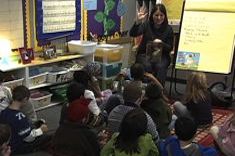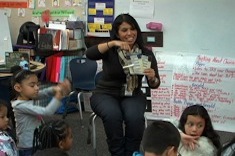Recent research indicates that increasing student engagement by 1 percent is correlated with a 6 percent increase in student performance on literacy assessments. We are not at all surprised, as there was already a well-established body of research on student engagement and its powerful connection to achievement across the disciplines.
We have long maintained that reading aloud to students is one of the most important and valuable ways to engage them in the work of reading, even beyond the read-aloud session. That is, read-alouds help students lean in to subsequent hard work—adopt a flexible mind-set—in shared, guided, and independent reading.
We find this connection particularly critical for the students who struggle with reading most. Unfortunately, these students are more likely to get less read-aloud, as they participate in reading interventions that remove them from other instructional opportunities and narrow the type of reading work they get to do.
Reading interventions tend to be focused on discrete, measurable skills (e.g., sight words, reading rate) or on reading short passages to answer comprehension questions. Often these interventions happen while others in the class listen to books read aloud or otherwise engage with more authentic texts. It seems that the students who need the magic of read-aloud most tend to be the ones who experience it least, which means that the students who are the farthest behind tend to get the least benefit from the engagement/achievement correlation.
We invite you to consider read-aloud as a valid and warranted intervention strategy, with the potential to shift student mind-sets, helping them lean in to the work and offering the increased achievement benefits enjoyed by engaged students. Here are a few ideas for working read-aloud into your interventions:
-
Spend at least one day per week reading aloud during intervention time.
Oftentimes, interventions are all about giving struggling students text and working alongside them as they solve the print and/or meaning problems that arise. If we shifted at least one day per week to include read-aloud for the duration of the intervention, we would give students access to new vocabulary; provide students a model of accurate, expressive reading; and promote the joy of reading, thus increasing the likelihood that the students would feel more inclined to read!
-
Spend five minutes per day reading aloud.
If dedicating an entire intervention block to read-aloud once a week feels like too much of a commitment, try offering students short, daily doses of read-aloud, particularly if you are offering portions of a connected story that can woo students to engage in the intervention work.
-
Connect other work to the read-aloud experience.
For example, if you model how to figure out the meaning of new words as you read aloud, make a chart of the things that you do. When students encounter a new word while engaged with text during shared or guided reading interventions, prompt them to refer to the chart that you made during read-aloud and try one of the strategies listed.
-
Repurpose the read-aloud text to lend authenticity to the intervention.
Once a text is read aloud, it becomes more accessible to students. You can reuse the read-aloud text by using it to directly address the purpose of the lesson. As appropriate, for example, if you are working on fluency, you can let the students do rereadings from the text you read aloud.
If the pinch of having too much work to do and too little time in which to do it raises concerns that read-aloud is a tricky fit for interventions, try imagining how learning would change if students were tripping over each other in an enthusiastic rush to participate in interventions. You can create energy for learning by reading aloud.
In her lovely book In the Company of Children, Joanne Hindley tells a story about how her father almost failed first grade. During the summer between his first and second year of school, the teacher told his mother that he must learn to read all the stories in the basal over the summer; otherwise he would have to repeat first grade.
The summer began with Joanne’s father sitting on the porch of their family’s lake house even as all his cousins frolicked in the water, laboring over the controlled vocabulary texts. After watching him struggle for a few days, his mother began to wonder if the problem had less to do with how her son read and more to do with what he was reading.
In a brilliant move that inevitably changed her son’s life, Joanne’s grandmother went to the library to check out pocket westerns. Then, she began reading aloud to her son. And just at the moment when the gunslingers were at opposite ends of the street or the bank robber entered the bank and said, “Stick ’em up!,” she paused the reading to take care of something in the house. Of course, Joanne’s father couldn’t wait for his mother to return to find out how the story ended. The lure of the characters and the storyline pulled him into the hard work. After enough time in pocket westerns, he was able to successfully read the basals, even though most of his work had been in other texts.
We invite you to experiment with read-aloud as a powerful support to the interventions you are doing with students. By giving readers who struggle an authentic incentive to lean in to the work, you are likely to increase engagement and, as research indicates, their reading achievement.









